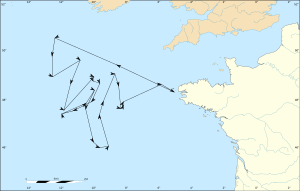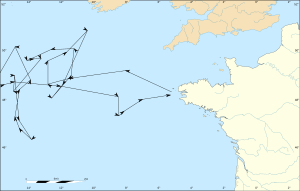Croisière du Grand Hiver facts for kids
Quick facts for kids Croisière du Grand Hiver |
|||||||
|---|---|---|---|---|---|---|---|
| Part of the naval operations during the War of the First Coalition | |||||||
 Républicain ran aground on Mingant rock. |
|||||||
|
|||||||
| Belligerents | |||||||
| Commanders and leaders | |||||||
| Strength | |||||||
| 3 frigates | 37 ships of the line 13 frigates 4 corvettes 6 brigs |
||||||
| Casualties and losses | |||||||
| None | 7 ships of the line destroyed | ||||||
The Croisière du Grand Hiver (which means "Campaign of the Great Winter" in French) was a big attempt by the French navy to sail during the winter of 1794-1795. This happened after a major sea battle called the Glorious First of June. The French hoped to show their strength at sea.
Contents
The Great Winter Cruise
Why This Trip Happened
The Glorious First of June was a very important naval battle. The French navy had won in a big way strategically. However, they had also lost many ships. It was their biggest loss since the Battle of La Hogue.
Later that year, the French government (called the National Convention) gave an order. They wanted a group of ships, led by Admiral Jean François Renaudin, to carry ammunition. This ammunition was needed from Brest to Toulon. Renaudin had just been promoted for bravely defending his ship, the Vengeur du Peuple. This happened during the Glorious First of June battle.
Renaudin's group had six large warships, three smaller frigates, and one corvette. Another admiral, Villaret-Joyeuse, was supposed to sail the main French fleet from Brest. His job was to protect Renaudin's ships in the Bay of Biscay. He would sail for two weeks and then return to Brest. He was also meant to send a smaller group of ships to Guadeloupe.
However, the French fleet was in bad shape. Many ships needed repairs. They also didn't have enough food for the sailors. After several tries, the fleet finally left port on December 24, 1794.
The Dangerous Journey Begins
Right as the fleet was leaving, a huge 110-gun ship called the Républicain had a problem. Its anchor cable broke. At 5:30 PM, before it could even set its sails, it hit a rock called Mingant rock. The ship started to get damaged and water began to flood in. Even though they threw its cannons overboard, they couldn't get it off the rock. The ship settled there as more water filled it.
The ship's small boats were damaged or lost. This made it impossible to get the crew off. The sea was very rough. It wasn't until 9:00 AM the next day that another ship, the Fougueux, arrived. It sent boats to rescue the sailors. In the end, only 10 men drowned, and the rest were saved.
Another ship, the Redoutable, also broke its cables. But it managed to reach the open sea. A frigate called Vertu followed it. By the afternoon of December 29, the 35 ships of the fleet gathered near Camaret-sur-Mer. They set sail again the next day.
The weather was terrible on January 1. The rough seas damaged several ships. The Nestor lost a mast and had to go back to Brest. The Téméraire had its hull damaged and started leaking water.
The next day, the weather got a bit better. Admiral Vanstabel turned his smaller group of ships to the North-West. But after a few hours, a thick fog rolled in. He lost contact with the main fleet. The Neptune had also been delayed earlier. It had problems with its capstan (a machine used to pull ropes). It too lost the fleet and joined Vanstabel's group on December 31. This group included three frigates and two corvettes. They wouldn't rejoin the main fleet until January 24.
Meanwhile, three British frigates were sent to check on the French fleet on January 2. One of them, HMS Diamond, was commanded by Captain William Sidney Smith. When the French fleet challenged it, HMS Diamond raised a French flag. This allowed it to sail past without trouble. Later, it found a stranded French ship. The French captain told HMS Diamond that his ship was the Nestor. Captain Smith spoke perfect French. He talked with the French officers and learned important information about their plans. HMS Diamond then sailed into Brest harbor on January 3 to confirm what it had learned.
Ships in Trouble
The Neptune had suffered a lot from the bad weather. Its captain had even warned Admiral Vanstabel. On January 25, another leak forced Neptune to turn its side. This was to keep the damaged part of its hull out of the water. It also sent out distress signals. For five days, most of the crew pumped water out of the ship. They also threw cannons, ammunition, and anchors overboard. Finally, on January 28, at 12:30 PM, the ship reached Perros-Guirec and ran aground. Fifty men were found dead inside the ship. The rest of the crew got off safely.
On January 28, a big storm hit. It caused more damage to several ships. The leak on the Téméraire became so bad that it turned back to Brest. But it got lost on the way and ended up in Saint-Malo.
After a few days of sailing, the Neuf Thermidor lost its front part (called the stem). This forced its captain to cut away the bowsprit (a pole sticking out from the front) and the top part of the front mast. He also had to throw anchors and cannons overboard. By January 29, the pumps couldn't keep up with the water leaking in. During the night, the ship rolled so much that parts of the main mast fell. This destroyed three pumps. From then on, the ship sank lower in the water. When the lower cannons touched the waves, other ships, the Majestueux and Marat, sent boats to rescue the crew. The Neuf Thermidor was empty by 4:00 AM on January 31. It sank around 7:00 AM.
The Superbe had a similar problem. It started taking on water on January 26. Captain Colomb had warned Admiral Villaret that his ship was sinking. Pumping water out didn't work, even after throwing cannons overboard. On January 30, Villaret ordered the ship to be left behind. The Montagne, Montagnard, and Papillon rescued the crew. But 21 men were lost.
The Scipion was an old ship that was supposed to be taken out of service soon. It started falling apart shortly after leaving the harbor. By January 25, its pumps couldn't keep up with the leaks. Other ships, the Montagnard, Trente-et-un-Mai, and Railleuse, were told to watch it. They tried to wrap it with cables, but it didn't work. Captain Huguet asked for permission to return to port. He was escorted by Trente-et-un-Mai. In the afternoon, the main topmast broke. It also broke the main yard, which went through the deck and broke two of the nine pumps. This made the ship fall apart even more. At 4:00 PM, Huguet asked Trente-et-un-Mai for help. The crew was rescued despite the rough sea. The ship was left empty by 3:15 AM the next morning.
The Convention lost its rudder (the steering part). It had to be pulled back to Lorient by the Pelletier.
On February 3, the fleet finally gathered back in Brest. They had captured 70 merchant ships. They also captured a 20-gun British ship called HMS Daphne. However, they had lost three of their own ships. Many others were badly damaged.
Admiral Renaudin's group had to delay its trip to Toulon. This was to help the rest of the fleet. Renaudin eventually left for Toulon on February 22. He sailed with several ships, including the Jemmappes and the Montagnard. They faced rough seas and strong winds. The Trente-et-un-Mai]] lost its mizzen mast (a mast at the back) and its main topmast when it entered the Mediterranean Sea. Another ship, the Tyrannicide, had to tow it. Despite these problems, they reached Toulon safely on April 2.
- Routes of the squadrons
What Happened Next
Overall, this campaign is seen as a big disaster for the French navy. They lost many ships without even fighting the British navy. Also, the damaged ships were hard to fix. This was because France didn't have enough materials in its shipyards. After this, the French navy largely stopped trying to challenge the British navy's power at sea.
Another attempt at a winter trip was made in December 1796. This was called the Expédition d'Irlande. It also ended in a similar disaster.



